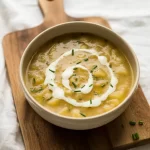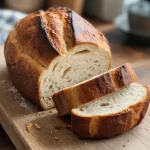There’s something so satisfying about transforming simple, humble ingredients into a beautifully crusty artisanal bread right in my own kitchen. The process of kneading, shaping, and waiting fills me with a serene sense of accomplishment and anticipation, making every bite of the freshly baked loaf truly rewarding.

I love to bake Boule bread the way the French do, because it is so simple and yet so tasty. The bread uses 3 1/4 cups of all-purpose flour as the main ingredient, something hardly anyone can rise up against.
The second ingredient is sea salt, which has no business being absent when you want to make good bread. Then we come to the third ingredient, sugar.
Without it, the yeast, which is also present, might rise, but the bread won’t taste much like bread. Finally, the ambient temperature and humidity of your kitchen must be just so, with the dough achieving its perfect state of hydration, in order for the bread to be everything it can be.
Ingredients

All-purpose flour: Abundant in carbohydrates, it imparts structure and texture.
Salt from the sea: Intensifies taste, crucial for regulating fermentation.
Sugars: Assist in yeast fermentation; add a slight sweet taste.
Yeast: Active dry yeast makes bread rise and fluff up.
Warm water: Turns on the yeast, gets the dough to just the right consistency.
Adding richness; improving crumb and crust texture: Olive oil.
Ingredient Quantities
- 3 1/4 cups (390g) all-purpose flour
- 2 teaspoons sea salt
- 1 teaspoon sugar
- 1 teaspoon active dry yeast
- 1 1/4 cups (300ml) lukewarm water
- 1 tablespoon olive oil
Instructions
1. In a big mixing bowl, combine the flour, salt, sugar, and yeast. These four components are the foundation of any good bread. They were about all we had, ingredient-wise, when we set out to make our first loaf.
2. Create a depression in the center of the flour mixture and pour the lukewarm water and olive oil into it. Stir until a shaggy dough forms.
3. Move the dough to a gently floured workspace and work it by hand for about 10 minutes. The dough should gradually become smoother and more elastic.
4. A large bowl should be lightly oiled with olive oil, the dough placed inside, and the dough covered with a damp cloth. It should be allowed to rise in a warm spot for approximately 1 to 2 hours, or until it has doubled in size.
5. When the dough has fully risen, press it gently to deflate it and return it to the floured surface. Form it into a boule. A boule is a round shape with a smooth exterior. To make a boule, keep the dough mostly in the center while you tuck the outer edges of the dough under itself as you diligently rotate it.
6. Put the molded dough on a baking sheet lined with parchment or on a floured banneton for the last proof. Drape a towel over it and let it rise once more for 30 to 45 minutes; it should look puffy and have a few bubbles on the surface.
7. Heat your oven to 450°F (230°C) and place a Dutch oven or cast iron pot inside to heat up.
8. When the oven has been preheated, take care to remove the pot from the oven. Transfer the risen dough gently into the pot, and with a sharp knife, score the top to allow it to expand.
9. Put a lid on the pot and bake for half an hour. Then take off the lid and continue baking for 10 to 15 minutes more, or until the top is golden brown and crisp.
10. Cool the boule on a wire rack for at least 20 minutes; then slice and serve.
Equipment Needed
1. Big mixing bowl
2. Measuring cups and spoons
3. Wooden spoon or dough whisk
4. Work surface (for kneading)
5. Kitchen scale (optional, for precise measurements)
6. Damp cloth
7. Large bowl (for dough rising)
8. Oil brush (for applying olive oil)
9. Baking sheet or floured banneton
10. Parchment paper (if using a baking sheet)
11. Towel (for covering dough)
12. Dutch oven or cast iron pot with lid
13. Sharp knife or bread lame (for scoring the dough)
14. Oven mitts or heat-safe gloves
15. Wire rack (for cooling the bread)
FAQ
- Q: Can I use bread flour instead of all-purpose flour?Yes, bread flour can be used. The dough will create a slightly chewier bread.
- Q: How do I store the boule once baked?Keep the bread at room temperature in a paper bag or wrapped in a clean dish towel. Countertop containers work too, as long as the bread isn’t stored in a plastic bag. When you go to serve the bread, it might not be as fresh as when you first bought it or baked it, but it should still taste good.
- Q: Can I make this bread without a stand mixer?This dough can definitely be mixed and kneaded by hand. It will take a few extra minutes of kneading, but it is certainly worth the effort.
- Q: Can I substitute active dry yeast with instant yeast?Yes, you can substitute it directly in the same amount. Instant yeast doesn’t need to be dissolved in water first.
- Q: What can I do if my dough is too sticky?Your dough might appear too sticky, but it can be revived. Simply add flour. Here’s how: Add flour, one tablespoon at a time, and mix thoroughly before adding more.
- Q: Is there an alternative to olive oil?Use melted butter or any neutral-flavored oil instead.
- Q: How can I tell if my boule is fully baked?A: When tapped on the bottom, the boules should sound hollow, but it is not assumed that bakers will have perfect pitch. Boules can also be removed from the oven when they reach an internal temperature of about 190°F (88°C).
Substitutions and Variations
For a chewier texture, substitute all-purpose flour with bread flour; for a denser, more rustic loaf, use whole wheat flour.
Kosher salt can replace sea salt in equivalent measures.
Honey or maple syrup can be used in equal measure as a substitute for sugar to impart a delicate sweetness.
You can substitute instant yeast for active dry yeast, using the same amount as the recipe calls for.
Melted butter or vegetable oil can replace olive oil for a slightly different flavor profile.
Pro Tips
1. Hydration Adjustment If the dough feels too dry or stiff while mixing, add a little more water, a tablespoon at a time. Different flours can absorb moisture differently, so adjusting the water can help achieve the right consistency.
2. Kneading Tip During the kneading process, use the “stretch and fold” technique after the initial mixing and resting period. This helps develop gluten more effectively, creating a better texture in the final bread.
3. Optimal Proofing Conditions To create a warm environment for proofing, place the covered bowl in a turned-off oven with just the light on. This method provides a consistent and slightly warm temperature, which helps the dough rise well.
4. Preheating the Dutch Oven Ensure that the Dutch oven or cast iron pot is fully heated before placing the dough inside. This will give the bread an excellent oven spring and a crispy crust.
5. Enhance Flavor Consider adding mix-ins like herbs, roasted garlic, or olives once the dough is initially combined. This can add delicious complexity to the flavor of the bread without altering the primary dough structure.

Classic French Boule Bread Recipe
My favorite Classic French Boule Bread Recipe
Equipment Needed:
1. Big mixing bowl
2. Measuring cups and spoons
3. Wooden spoon or dough whisk
4. Work surface (for kneading)
5. Kitchen scale (optional, for precise measurements)
6. Damp cloth
7. Large bowl (for dough rising)
8. Oil brush (for applying olive oil)
9. Baking sheet or floured banneton
10. Parchment paper (if using a baking sheet)
11. Towel (for covering dough)
12. Dutch oven or cast iron pot with lid
13. Sharp knife or bread lame (for scoring the dough)
14. Oven mitts or heat-safe gloves
15. Wire rack (for cooling the bread)
Ingredients:
- 3 1/4 cups (390g) all-purpose flour
- 2 teaspoons sea salt
- 1 teaspoon sugar
- 1 teaspoon active dry yeast
- 1 1/4 cups (300ml) lukewarm water
- 1 tablespoon olive oil
Instructions:
1. In a big mixing bowl, combine the flour, salt, sugar, and yeast. These four components are the foundation of any good bread. They were about all we had, ingredient-wise, when we set out to make our first loaf.
2. Create a depression in the center of the flour mixture and pour the lukewarm water and olive oil into it. Stir until a shaggy dough forms.
3. Move the dough to a gently floured workspace and work it by hand for about 10 minutes. The dough should gradually become smoother and more elastic.
4. A large bowl should be lightly oiled with olive oil, the dough placed inside, and the dough covered with a damp cloth. It should be allowed to rise in a warm spot for approximately 1 to 2 hours, or until it has doubled in size.
5. When the dough has fully risen, press it gently to deflate it and return it to the floured surface. Form it into a boule. A boule is a round shape with a smooth exterior. To make a boule, keep the dough mostly in the center while you tuck the outer edges of the dough under itself as you diligently rotate it.
6. Put the molded dough on a baking sheet lined with parchment or on a floured banneton for the last proof. Drape a towel over it and let it rise once more for 30 to 45 minutes; it should look puffy and have a few bubbles on the surface.
7. Heat your oven to 450°F (230°C) and place a Dutch oven or cast iron pot inside to heat up.
8. When the oven has been preheated, take care to remove the pot from the oven. Transfer the risen dough gently into the pot, and with a sharp knife, score the top to allow it to expand.
9. Put a lid on the pot and bake for half an hour. Then take off the lid and continue baking for 10 to 15 minutes more, or until the top is golden brown and crisp.
10. Cool the boule on a wire rack for at least 20 minutes; then slice and serve.
















